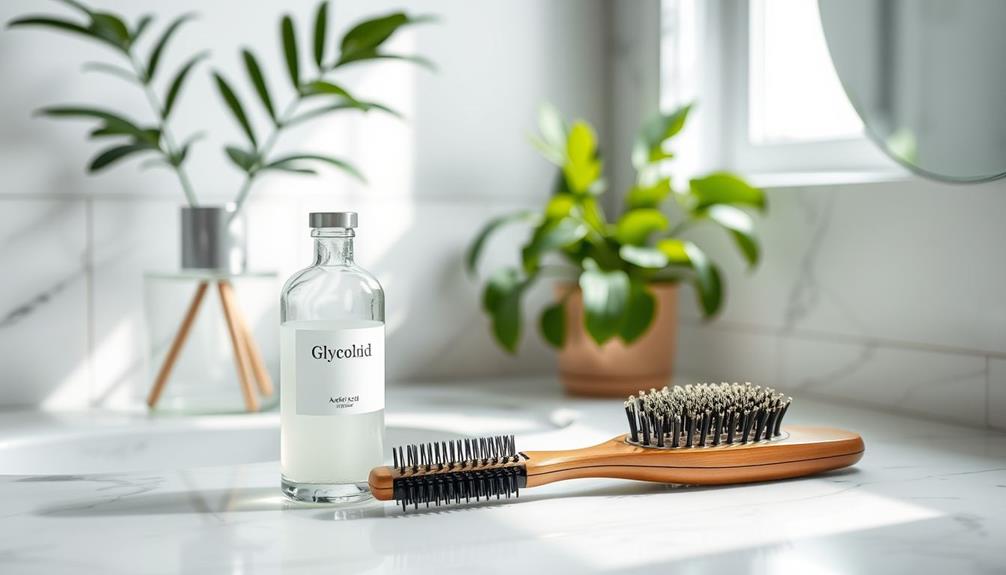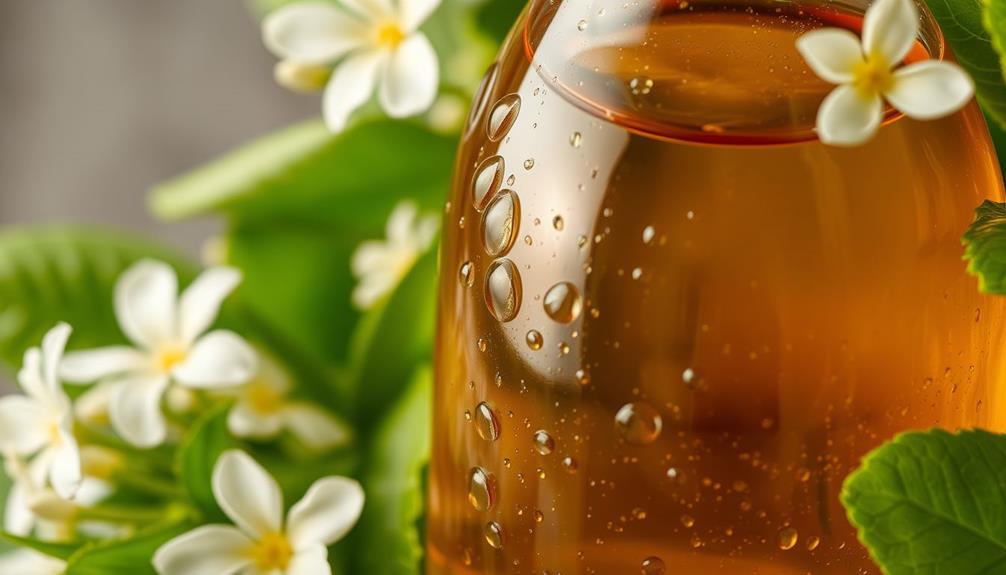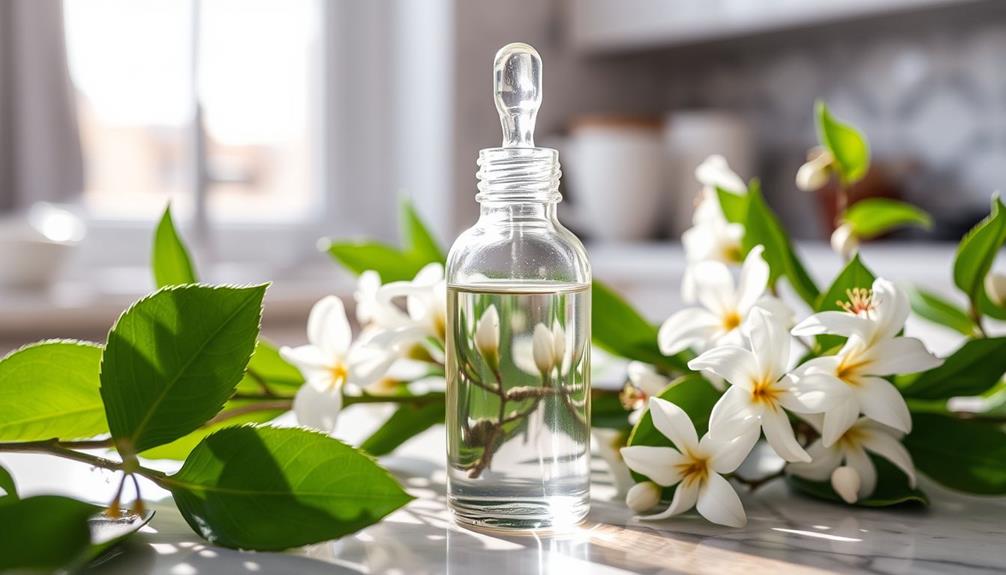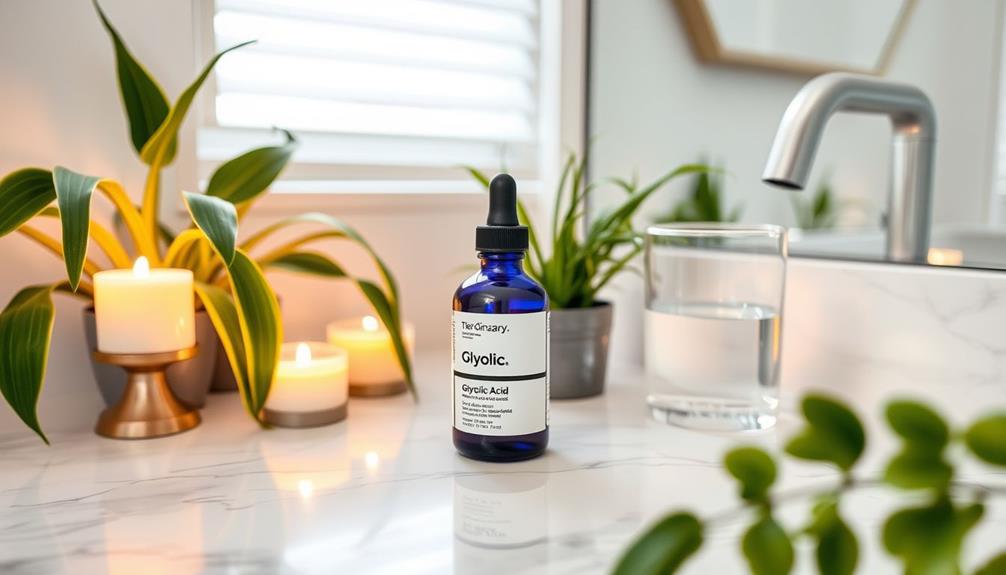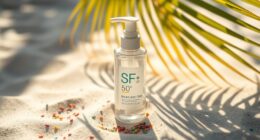Glycolic acid's a fantastic choice for promoting a healthy scalp. It acts as an exfoliant, removing dead skin cells and product buildup, which enhances hair growth. By attracting and retaining moisture, it keeps your scalp hydrated and reduces dryness. Additionally, its antimicrobial properties help clear away impurities, leading to a clearer scalp and less dandruff. Start with a lower concentration to avoid irritation, and use it once or twice a week for best results. With consistent application, you'll see a noticeable improvement in scalp health and hair growth potential. Curious about other benefits? There's more to uncover!
Key Takeaways
- Glycolic acid, an alpha hydroxy acid, promotes scalp exfoliation by dissolving dead skin cell bonds, leading to a healthier scalp environment.
- It enhances hydration by attracting moisture, alleviating dryness and flakiness for improved scalp comfort.
- The acid stimulates blood circulation, potentially promoting hair growth by delivering essential nutrients to hair follicles.
- Its antimicrobial properties help reduce yeast and bacteria, minimizing issues like dandruff and scalp acne.
What Is Glycolic Acid?

Glycolic acid is an alpha hydroxy acid (AHA) derived from sugar cane that penetrates deeply into your skin and scalp, making it a powerful exfoliant. Its small molecular size allows glycolic acid to dissolve the bonds between dead skin cells effectively, promoting exfoliation and enhancing cell turnover.
This process is vital for maintaining healthy scalp health, as it encourages the shedding of old skin, making way for fresh cells. Additionally, integrating essential oils for specific conditions into your routine can further enhance scalp care by providing targeted benefits.
When you incorporate glycolic acid into your hair care routine, you're not just exfoliating; you're also harnessing its properties as a moisture magnet. This means it attracts and retains moisture, helping to combat dryness and flakiness on your scalp.
As a result, your scalp can achieve ideal hydration levels, which is essential for overall scalp health. Typically found in concentrations ranging from 5% to 20%, it's important to choose lower concentrations for scalp applications to minimize irritation.
Benefits for Scalp Health

Incorporating glycolic acid into your scalp care routine offers a variety of benefits that enhance overall scalp health and hair vigor. This powerful ingredient works to exfoliate the scalp, helping to remove dead skin cells and product buildup. By doing so, it creates a healthier environment for your hair to thrive, much like the benefits of regular trims for healthy hair. Here are some key advantages:
- Improved Hydration: Glycolic acid boosts hydration levels in your scalp, combating dryness and flakiness often linked to dandruff and psoriasis. Regular use of <a target="_blank" href="https://thenightingalehairstudio.com">hair treatments for damage</a> can complement this benefit by restoring moisture to the hair strands.
- Stimulated Hair Growth: By enhancing blood circulation, glycolic acid promotes nutrient delivery to hair follicles, potentially leading to improved hair growth and reduced hair loss.
Regular use of glycolic acid not only helps to exfoliate the scalp effectively but also restores the pH balance. This balance is essential for preventing issues like hair shaft swelling and maintaining peak hair condition. With these benefits, glycolic acid is a must-have for anyone looking to elevate their scalp health.
Mechanism of Action
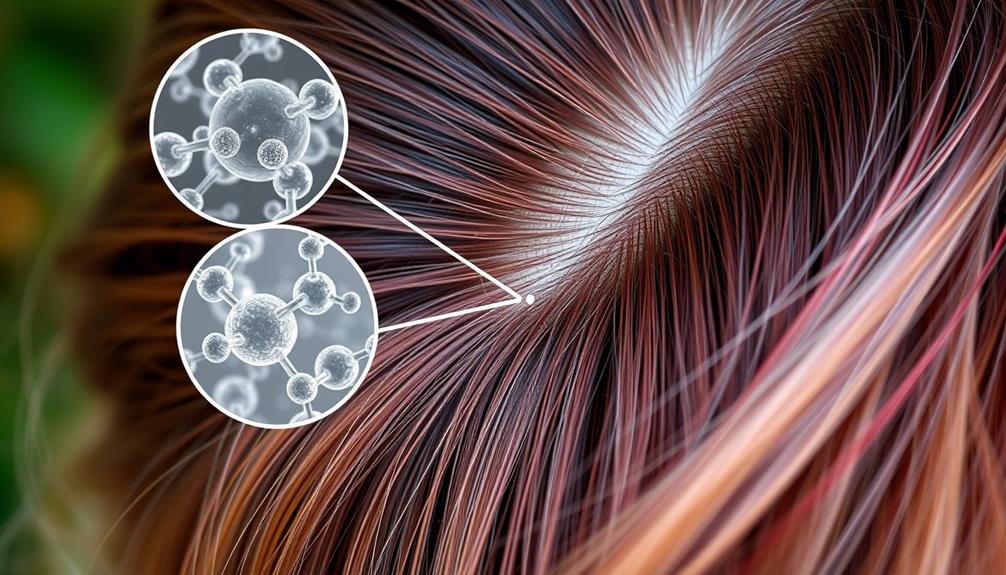
The mechanism of action for glycolic acid lies in its ability to penetrate deeply into the scalp, effectively breaking down the bonds between dead skin cells and facilitating their removal.
By exfoliating the scalp, glycolic acid helps reduce buildup that can hinder scalp health. This process not only clears away debris but also promotes a healthier environment for hair follicles, leading to healthy hair growth.
Incorporating essential oils for hair growth can further enhance this effect by promoting circulation to the scalp, thereby delivering essential nutrients to hair follicles.
Moreover, glycolic acid acts as a moisture magnet. It enhances hydration levels by stimulating the production of hyaluronic acid and collagen in the scalp.
This boost in moisture helps maintain the scalp's balance, preventing dryness and irritation. Additionally, by balancing the pH of your scalp, glycolic acid creates ideal conditions for hair follicles to thrive.
Another important aspect is its antimicrobial properties. Glycolic acid helps reduce the presence of bacteria and yeast on the scalp, which can contribute to issues like dandruff and scalp acne.
How to Use Glycolic Acid
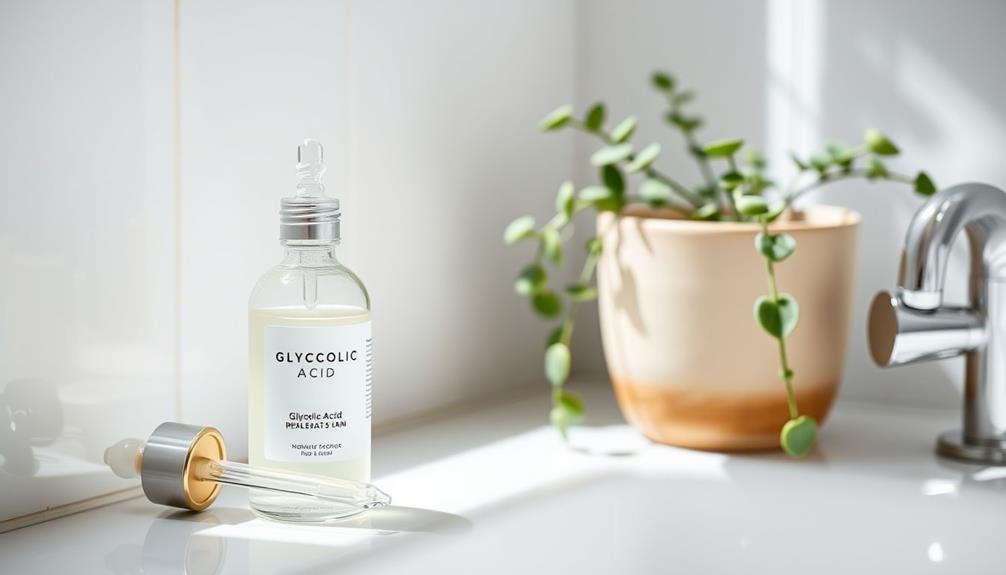
To effectively harness the benefits of glycolic acid for your scalp, it's important to know how to use it properly. Start by choosing a glycolic acid product that suits your needs, then follow these steps for safe application: One option is to contemplate using an air purifier to reduce allergens and pollutants in your environment, which can enhance the overall health of your scalp and hair. This is especially beneficial for those with sensitivities, as air purifiers improve indoor air quality considerably.
- Perform a patch test: Before you fully apply glycolic acid products, test a small area on your skin to check for any adverse reactions, especially if you have sensitive skin.
- Apply glycolic acid products: Use the product once or twice a week. Applying it at night helps minimize sensitivity to sunlight and reduces the risk of scalp irritation.
Remember to follow the specific directions of your chosen product, as some may require a leave-on time of 5-10 minutes before rinsing. By taking these precautions, you can enjoy the benefits of glycolic acid while keeping your scalp healthy and irritation-free.
Hair Type Considerations
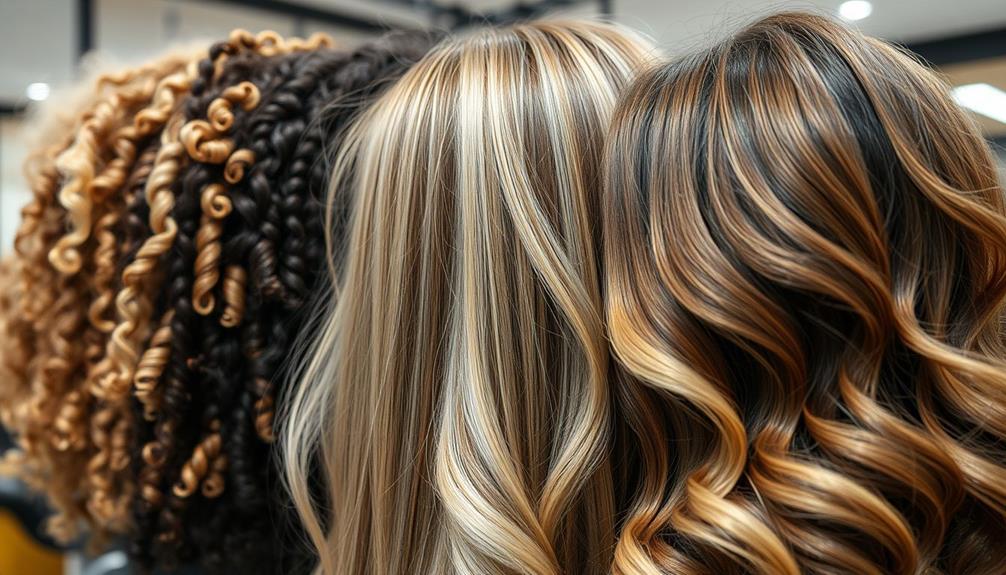
When considering glycolic acid for your scalp, think about your hair type.
If you've got an oily scalp, it can be a great option to help manage excess oil and flakiness.
However, if your skin is sensitive, you'll want to approach with caution to avoid irritation.
Ideal for Oily Scalps
Glycolic acid stands out as a powerful ally for those dealing with oily scalps, effectively cutting through excess oil and buildup for a healthier scalp environment. If you struggle with an oily scalp, incorporating glycolic acid into your hair care routine can make a significant difference. It works to exfoliate dead skin cells, alleviating flakiness and preventing clogged hair follicles.
Here are some key benefits of using glycolic acid for your oily scalp:
- Reduces excess oil: Glycolic acid helps balance oil production, giving you a fresher feel between washes.
- Enhances scalp health: Regular use promotes a cleaner, healthier scalp, reducing the likelihood of irritation or acne.
For ideal results, you can safely use glycolic acid 1-2 times a week. This allows you to maintain moisture balance without over-exfoliating your scalp.
Caution for Sensitive Skin
Sensitive scalps require extra caution with glycolic acid, as it can lead to irritation or adverse reactions, especially at higher concentrations. If you have sensitive skin, it's essential to approach glycolic acid carefully to avoid discomfort.
Start with a patch test to gauge your skin's tolerance. Here's a quick reference table to help you understand how to use glycolic acid safely:
| Consideration | Recommendation | Reason |
|---|---|---|
| Concentration | Lower concentrations (around 5%) | Reduces risk of irritation |
| Application Frequency | Once every two weeks | Allows time for scalp to adjust |
| Patch Test | Perform before full application | Determines skin's reaction and tolerance |
| Scalp Conditions | Avoid if open sores or lesions exist | Prevents exacerbating irritation |
| Consultation | Speak with a dermatologist | Tailors usage to your specific needs |
Product Compatibility

When choosing products with glycolic acid, it's essential to take into account what pairs well and what doesn't.
You'll want to avoid mixing it with vitamin C to prevent irritation.
Additionally, opting for lower concentrations can help if you have a sensitive scalp while still reaping the benefits of this powerful ingredient.
Ideal Product Pairings
For ideal scalp health, pair glycolic acid with other exfoliants like beta-hydroxy acids to enhance product efficacy. This combination helps you effectively exfoliate your scalp, removing product buildup and promoting healthier hair growth. Many formulations on the market incorporate glycolic acid, making it easier for you to integrate this powerhouse ingredient into your scalp care routine.
Consider the following product pairings for best results:
- Beta-hydroxy acids: These can penetrate deep into the pores, working alongside glycolic acid to clear away impurities and excess oil.
- Clarifying shampoos: These products help remove stubborn buildup, making sure that glycolic acid can work more effectively.
Always check the labels of your products to verify compatibility and safe usage. For those with sensitive scalps, opt for lower concentration formulations of glycolic acid to minimize irritation while still achieving the desired benefits.
Avoiding Harmful Combinations
Steering product compatibility is essential to guarantee you reap the full benefits of glycolic acid without causing irritation to your scalp. When you're using glycolic acid, be mindful of what you're combining it with. Some combinations can lead to an itchy scalp or worsen existing skin conditions.
Here's a quick reference guide to help you navigate product compatibility:
| Ingredient | Action |
|---|---|
| Vitamin C | Avoid using—conflicting pH levels |
| Beta-Hydroxy Acids (BHAs) | Can enhance benefits—use together |
| Retinoids | Consult with a dermatologist before using |
| Other Exfoliants | Check compatibility—may irritate skin |
Before diving into a new routine, always check product labels for specific usage instructions. If you've got sensitive skin, opt for lower concentrations of glycolic acid to reduce irritation risk. It's also wise to consult with a dermatologist before using glycolic acid, especially if you're dealing with potent ingredients or specific scalp conditions. By paying attention to these factors, you can enjoy a healthier scalp without unnecessary discomfort.
Concentration Recommendations
Choosing the right concentration of glycolic acid is crucial for maximizing its benefits while minimizing irritation on your scalp. Typically, glycolic acid concentrations between 5% to 10% are recommended for scalp treatments, with 7% being a solid choice for effective exfoliation. If you have a sensitive scalp, it's wise to start with lower concentrations to gauge your tolerance before moving up.
Here are some key recommendations when selecting glycolic acid products:
- Begin with 5% concentration for sensitive skin to minimize irritation.
- Gradually increase to 7% or 10% for enhanced exfoliation as your scalp adjusts.
Keep in mind that glycolic acid can be found in various formulations like shampoos and conditioners, making it easier to incorporate into your hair care routine.
However, avoid using it alongside vitamin C, as this combination can lead to adverse reactions. By following these concentration recommendations, you can enjoy the benefits of glycolic acid treatments while maintaining a healthy scalp.
Safety and Side Effects

Glycolic acid is typically safe for most skin types at low concentrations, but it's important to be aware of potential side effects, especially if you have sensitive skin.
While using glycolic acid at concentrations below 10% and a pH of 3.5 or higher is generally safe, those with sensitive skin may still experience irritation, redness, or itchiness.
Overusing glycolic acid can lead to dryness and increased sensitivity to sunlight, so always follow up with sunscreen.
To prevent adverse reactions, avoid applying glycolic acid on open wounds, lesions, or areas of sensitive skin.
Rarely, users may experience serious side effects like chemical burns or contact dermatitis, particularly if applied improperly.
It's vital to perform a patch test before trying new products containing glycolic acid. This simple step helps identify any potential allergic reactions, allowing you to use the product more confidently.
Expert Recommendations

Before adding glycolic acid to your scalp care routine, it's wise to consult a board-certified dermatologist to ascertain it suits your specific needs and skin type.
Expert recommendations emphasize starting slowly and carefully, especially if you have sensitive skin or existing scalp conditions. Here are some key points to evaluate:
- Begin with lower concentrations of glycolic acid serum (around 5-7%) and gradually increase usage frequency, ideally once or twice a week.
- Monitor your scalp's reaction closely. If you notice irritation, redness, or excessive dryness, discontinue use immediately.
These guidelines can help optimize your scalp treatments and improve the health of the scalp.
Additionally, keep an eye on ongoing research regarding glycolic acid in hair care products, as recommendations may evolve over time. Always prioritize your comfort and safety, and don't hesitate to seek professional advice if issues persist.
Alternatives and Complementary Practices

Exploring alternatives and complementary practices can enhance your scalp care routine, ensuring you achieve ideal results alongside glycolic acid treatments.
One effective option is salicylic acid, which exfoliates the scalp by breaking down dead skin cells and reducing oiliness. Incorporating this alongside glycolic acid can maximize your scalp treatments and promote healthier hair growth.
Don't overlook the power of regular scalp massages. They can greatly boost blood circulation, delivering essential nutrients to your hair follicles for improved scalp health.
Maintaining a balanced scalp pH is also essential; using pH-balanced shampoos and conditioners can help you achieve this balance, setting the stage for optimal hair growth.
In addition, consider adding moisturizing treatments and nourishing masks to your routine. These products can provide hydration and support scalp health, complementing glycolic acid's exfoliating properties.
What to Expect When Using

When you start using glycolic acid on your scalp, you can expect noticeable improvements in scalp health and reduced product buildup.
Many users report enhanced hair growth due to better hydration and circulation.
Just remember to monitor how your scalp reacts to avoid any irritation.
Improved Scalp Health
What benefits can you expect from using glycolic acid for your scalp health? By incorporating glycolic acid into your routine, you'll notice several improvements that can lead to a healthier scalp. This powerful ingredient works to exfoliate dead skin cells, creating a cleaner environment for your hair follicles and reducing issues like flakiness and irritation.
Here's what you can look forward to:
- Enhanced hydration: Glycolic acid helps balance moisture levels by removing excess oil and product buildup, keeping your scalp nicely hydrated.
- Improved blood circulation: Regular use boosts blood flow, ensuring that essential nutrients reach your hair follicles, which may promote growth and reduce breakage.
With consistent application, you can expect a gradual transformation in your scalp health. The exfoliating properties of glycolic acid not only keep your scalp clear but also pave the way for vibrant, healthy hair.
Reduced Product Buildup
Using glycolic acid helps you effectively reduce product buildup on your scalp, leading to a cleaner and healthier environment for your hair. This powerful exfoliant works by breaking down dead skin cells and dissolving clusters of product buildup, which can clog hair follicles and hinder scalp health.
When you incorporate glycolic acid into your routine, you'll notice a significant reduction in excess oil and sebum, giving your scalp a fresher and more balanced feel. Regular use of glycolic acid promotes enhanced cell turnover, which not only helps with flakiness and irritation often associated with dandruff but also keeps your scalp in top condition.
As you exfoliate, you'll likely experience less irritation and discomfort, making your scalp a more inviting place for hair growth. Over time, you may find that you rely less on clarifying shampoos since glycolic acid efficiently maintains scalp cleanliness.
This means your hair can thrive in a healthier environment, free from the burden of product buildup. With consistent application, you're setting the stage for improved scalp health and happier hair.
Enhanced Hair Growth
Glycolic acid considerably boosts hair growth by exfoliating your scalp, allowing for better nutrient absorption and healthier hair follicles. When you incorporate glycolic acid into your scalp treatments, you'll likely notice several benefits that promote enhanced hair growth:
- It effectively removes dead skin cells, unclogs hair follicles, and improves nutrient delivery to your hair roots.
- Regular use enhances blood circulation in the scalp, fostering a healthier environment for hair growth and potentially reducing hair loss.
As you continue using glycolic acid, you may see improvements in the overall texture and volume of your hair.
Healthier hair growth comes from stronger hair strands, which is a direct result of revitalized hair follicles.
By keeping your scalp clean and free from excess oil and product buildup, glycolic acid creates an ideal foundation for your hair to thrive.
Embrace the transformation, and enjoy the journey to a fuller, healthier mane!
Conclusion
Incorporating glycolic acid into your scalp care routine can be a game changer.
Imagine the invigorating sensation as it gently exfoliates, revealing a healthier, more vibrant scalp beneath.
You'll not only feel the difference but see it too, with hair that looks fuller and more radiant.
Embrace this transformative journey, and watch as your scalp breathes new life, paving the way for luscious locks.
Your hair deserves this revitalizing boost, so why not give it a try?
